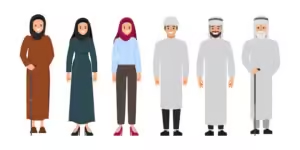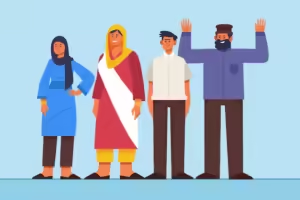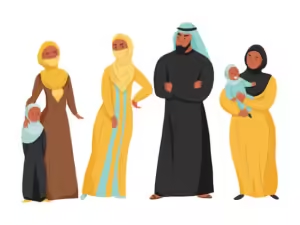Muslim men’s dress isn’t just about style; it is a matter of belief, tradition, and Islamic teachings on dressing, as outlined in the Quran and Hadith. The humble, respected, and positive identity of clothing is the message conveyed in the Islamic tradition about clothing. Clothing, for Muslim men, is not only a religious issue but also a cultural one. In this article, let’s learn about what traditional Muslim men wear, why this clothing is essential, and valuable lessons about dressing modestly gleaned from the Qur’an and Sunnah.
1. Humility in Dress Code Among Muslims
Islamic clothing reflects purity, justice, and righteousness, as Islam is a religion of peace. While specific types of dress may vary widely between cultures, the essence of Muslim attire remains consistent in its aim: to preserve decency and show respect to the self and others. The Quran forbids Muslims to dress modestly in a manner that does not reveal the body unusually. One key verse emphasizes this concept:
يَا بَنِي آدَمَ قَدْ أَنْزَلْنَا عَلَيْكُمْ لِبَاسًا يُوَارِي سَوْآتِكُمْ وَرِيشًا وَلِبَاسُ التَّقْوَىٰ ذَٰلِكَ خَيْرٌ
“O children of Adam, We have provided you with garments to cover your nakedness and as an adornment. But the garment of righteousness—that is best.”
(Surah Al-A’raf, 7:26)
In this verse, Allah stresses the aspect of beautification, where apparel should be worn, but ‘the garments of righteousness ‘, which is the taqwa, are better. This phrase points to the deeper meaning of dress in Islam: above the skin, it refers to the need to act and live as a gentleman or lady, man or woman.
2. Shariah and the Sunnah—What the Hadith Says about Men’s Clothing
Prophet Muhammad (peace be upon him) has also shed more light on what Muslims should wear. Tahiyyah in Islam is not about putting restraints but creating a frame of mind of decent behaviour. Muhammad did not like people to dress in colourful clothes or in a way that could be seen as prideful. He said:
“كُلُوا وَاشْرَبُوا وَالْبَسُوا وَتَصَدَّقُوا فِي غَيْرِ إِسْرَافٍ وَلا مَخِيلَةٍ”
“Eat, drink, give charity, and wear clothes, but without extravagance or pride.”
(Sahih al-Bukhari)
This hadith affirms the Muslim way of dressing by discouraging them from being extravagant or proud in their attire. Instead, in Islam, the dress code should be based on actual humbleness and the recognition of the deity Allah. In this regard, Muslim men value the religious side of dressing; thus, it is not the exterior look that counts.
3. Traditionally, Muslim men’s dress styles
Malay and Indonesian men’s clothing differs from Middle Eastern men’s clothing, even though Malay and Indonesian are part of the larger Asian Muslim society; hence, their dress code reflects a blend of specialized cultural practices in dressing and universal Islamic principles. All these traditional costumes, in one way or another, bear testament to the original intention of promoting modesty and dignity, and yet fit the cultural requirements. Here are some popular styles of Muslim men’s dress and their unique significance:
Thobe (or Thawb)
Thobes are a kind of gown usually worn in the Middle East region, North Africa, and to some extent in East Asian countries. It is more like reaching the ankles in length and has long sleeves. Again, the cloth used makes it loose-fitting due to Islamic tenets of dressing, which do not emphasize the contours of the clothing. The free and accessible nature of the thobe aligns with the culture of soft decency and politeness, which is why it is popular in many countries with significant Palestinian and Arab populations.
Shalwar Kameez
Initially designed for active women in the Islamic world, the shalwar kameez is a two-piece garment comprising a directly fitting tunic and loose trousers. This heel style is preferred because it is comfortable and stylish, making it suitable for working women and other occasions. The shalwar kameez holds immense value, symbolizing cultural and religious identity; the slack cut and fit appear to be Islamic concepts of conservative dressing.
Jubba and Bisht
The Jubba, which resembles the thobe, is typically worn on more formal occasions. It is also called a Jubba or thobe and, together with the Bisht, an outer cloak worn on formal occasions or in religious ceremonies. The Bisht layers an aesthetic of a fancy look without vulgarity and is perceived as a symbol of status or respect in most societies.
Kufi and Turban
Other pretty standard accessories among Muslim men include the kufi—a small, rounded cap—and the turban. The kufi is typically acceptable to wear during prayer and conveys humility or respect. The preferred headwear is the turban, which is frequently associated with Middle Eastern and South Asian origins and is sometimes used to describe the cultural standing of a scholar or clergyman.
4. The Real Downtrodden Advantages of Humble Attire
Humble garments signify religious significance. In addition to having religious connotations, they have other functions. The Islamic clothing in most countries is suitable for hot weather, despite being protective from the sun. Light clothing allows air to pass through to reach the skin, cooling it and providing protection from the sun.
Besides climate reasons, modest dressing also makes the dressing process more conscious. Since purchasing clothing that adheres to Islamic culture is important, Muslim men are expected to be mindful of their religion whenever they undertake their respective tasks. This continuous encouragement of spiritual practices reminds me to keep practising core Islamic values.
5. Veil and Other Reforms: Views of Islamic Dress as a Different Form of Faith and Self-Expression
The Quran and Hadith also presented dress as more than a means of concealing the body, but a way of showing obeisance, commitment, and loyalty to a group. Islamic dress is a constant sign of one’s status as a Muslim and the code by which one lives. These dress codes ensure that Muslim men offer the best image of the religion, and they are seen as representatives of Islam.
Muslims are encouraged to appreciate beauty in its diverse forms, especially in external appearance. He said:
“إِنَّ اللَّهَ جَمِيلٌ يُحِبُّ الْجَمَالَ”
“Allah is beautiful and loves beauty.”
(Sahih Muslim)
This hadith demonstrates that modesty is valued in a woman’s beauty, but beauty in moderation is equally appreciated. Wearing a good dress and being decent is a mark of thankfulness to Allah, following the outer looks with outer character.
6. Conclusion: Dressing as an Act of Worship
Islam, being a religion that plays almost every aspect of human life, advises Muslims on the type of dress to wear since it’s a reflection of the inner person. Muslim men’s clothing is, first of all, a sign they use on their bodies to remember specific moral standards, and secondly, it is a sign of belonging to a worldwide community. In other words,
Muslim men will be able to respect cultural practices and, at the same time, ensure that they are not violating Quran/Hadith injunctions regarding proper conduct, including such haraam acts as having illegal sexual connections.
Modern critical trends in mass fashion express identity. In today’s world of dressing in Islamic garments, it still possesses a deep, sincere, and dignified sense of beauty as the right and true Mold. According to these and similar benchmarks, Muslim men’s dress proves their allegiance to a religion that indeed celebrates not mere outer beauty but also inner essence.




